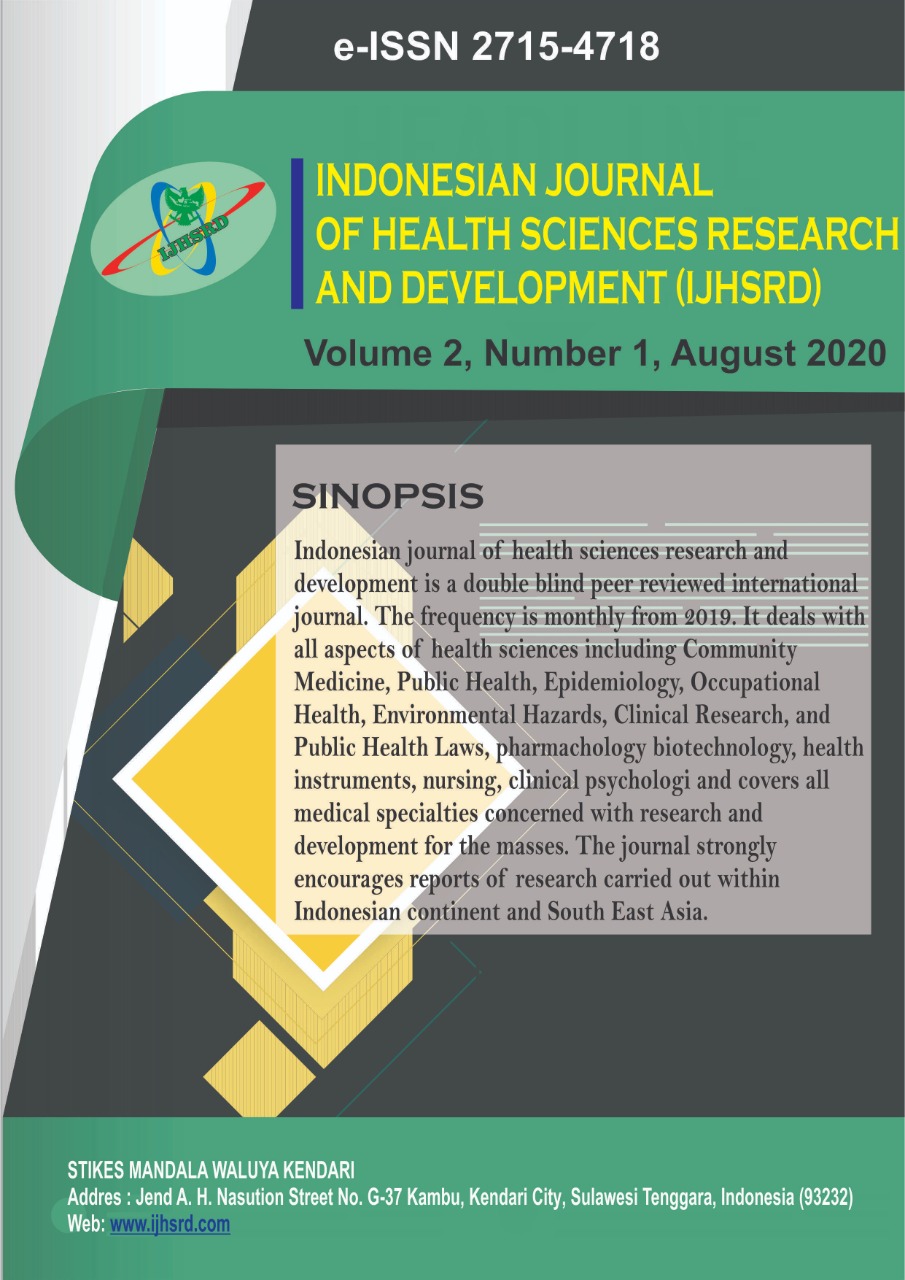Main Article Content
Abstract
Background: Nutrition is still a public health problem in Indonesia. Good nutritional intake cannot be provided by children, because of the mother's knowledge, family income, and nutritional intake. Analysis of the factors that influence nutrition in children under five in Petoaha Village.
Methods:This type of research is an analytic observational with cross-sectional study design. The population and sample in this study were under nutrition data in Petoaha Village.
Results:The results of the path analysis show that the model fits the data with a value of RMSEA = 0.000 <0.10. Furthermore, based on the pathway with the estimation model and the t calculation shows that four factors are interrelated based on the tcalculation> 1.96, namely between income and under nutrition getting tcalculation n = 3.25; knowledge by under nutrition obtained tcalculation = 5.06; knowledge of nutritional intake was obtained by tcalculation = 2.10 and malnutrition intake, tcalculation = 2.16.
Conclusion: It is hoped that it can become an information reference for policymakers in implementing preventive and promotive efforts from an early age to the community in overcoming under nutrition.
Keywords
Article Details

This work is licensed under a Creative Commons Attribution-ShareAlike 4.0 International License.
References
- Soekirman. Taking the Indonesian nutrition history to leap into betterment of the future generation: development of the Indonesian Nutrition Guidelines. Asia Pacific Journal of Clinical Nutrition. 2011;20(3):447-51.
- Merryana Adriani S, Kes M. Pengantar gizi masyarakat: Prenada Media; 2016.
- Unicef. WHO, World Bank Group (2017) Levels and trends in child malnutrition. USA: UNICEF, WHO & World Bank Group. 2017.
- Gupta P, Zhao D, Guallar E, Ko F, Boland MV, Friedman DS. Prevalence of glaucoma in the United States: the 2005–2008 national health and nutrition examination survey. Investigative ophthalmology & visual science. 2016;57(6):2905-13.
- Corsi DJ, Subramanyam MA, Subramanian S. Commentary: Measuring nutritional status of children. International journal of epidemiology. 2011;40(4):1030-6.
- Koletzko B, Bhatia J, Bhutta ZA, Cooper P, Makrides M, Uauy R, et al. Pediatric nutrition in practice: Karger Medical and Scientific Publishers; 2015.
- Black RE, Alderman H, Bhutta ZA, Gillespie S, Haddad L, Horton S, et al. Maternal and child nutrition: building momentum for impact. The Lancet. 2013;382(9890):372-5.
- Penelitian B. Riset kesehatan dasar (Riskesdas) 2013. Lap Nas. 2013;2013(1):384.
- Tenggara DKPS. Profil Kesehatan Provinsi Sulawesi Tenggara Tahun 2018. Kendari: Dinas Kesehatan Provinsi Sulawesi Tenggara. 2019.
- Kendari DKK. Profil Dinas Kesehatan Kota Kendari. 2018.
- Garson GD. Path analysis: Statistical Associates Publishing Asheboro, NC; 2013.
- Sarwono J. Analisis Jalur (Path Analysis). Jakarta: Gramedia. 2011.
- Riadi E. Aplikasi LISREL untuk penelitian analisis jalur. Yogyakarta: CV Andi Offset. 2013.
- Fadmi FR, Mulyani S, Buton LD. Geographically Weighted Regression (GWR) Approach in the Modeling of Malnutrition and the Influencing Factors in Muna Regency. Indian Journal of Public Health Research & Development. 2018;9(6).
- Rodrigues WN, Colodetti TV, Martins LD, Brinate SVB, Tomaz MA, do Amaral JFT. Nutritional components of growth of Arabica coffee genotypes cultivated under different levels of phosphorus fertilization studied by path analysis. Australian Journal of Crop Science. 2015;9(12):1214.
- Mulyati T, Ginting FR, Bahagiawati H, Aizahroni A. Hubungan antara Pengetahuan tentang Anemia dengan Asupan Gizi pada Ibu Hamil dengan Resiko Terjadinya Anemia dalam Kehamilan di Puskesmas Kecamatan Kembangan, Jakarta Barat Periode 10-18 Desember 2007. Ebers Papyrus. 2018;13(4):169-76.
- Ahmed T, Roy S, Alam N, Hossain MI. Determinants of undernutrition in children under 2 years of age from rural Bangladesh. Indian pediatrics. 2012;49(10):821-4.
- Kaleem R, Adnan M, Naveed S. Association of mothers’ socio-demographic characteristics with their knowledge and practices about complementary feeding. Journal of Fatima Jinnah Medical University. 2018;12(2).
- Yabanc? N, K?saç ?, Karaku? S?. The effects of mother’s nutritional knowledge on attitudes and behaviors of children about nutrition. Procedia-Social and Behavioral Sciences. 2014;116:4477-81.
- Syeda B, Agho K, Wilson L, Maheshwari GK, Raza MQ. Relationship between breastfeeding duration and undernutrition conditions among children aged 0–3 Years in Pakistan. International Journal of Pediatrics and Adolescent Medicine. 2020.
- Fadare O, Amare M, Mavrotas G, Akerele D, Ogunniyi A. Mother’s nutrition-related knowledge and child nutrition outcomes: Empirical evidence from Nigeria. PloS one. 2019;14(2).
- Wu Y. What is known about children's undernutrition and health levels in China–An empirical analysis from 1991 to 2009. Children and Youth Services Review. 2019;96:372-80.
- Bhandari S, Ghosh M, Bose K. Socio-Demographic Characteristics and Prevalence of Under Nutrition among Adult Sabars of Bankura District, West Bengal, India. International Journal of Advancement in Life Sciences Research. 2019:1-10.
- Owoaje E, Onifade O, Desmennu A. Family and socioeconomic risk factors for undernutrition among children aged 6 to 23 Months in Ibadan, Nigeria. The Pan African medical journal. 2014;17.
- Saputra W, Nurrizka RH. Faktor demografi dan risiko gizi buruk dan gizi kurang. Makara kesehatan. 2012;16(2):95-101.
- Fadmi FR, Mulyani S. ANALISIS FORECASTING PADA JUMLAH KASUS GIZI BURUK DI PROVINSI SULAWESI TENGGARA TAHUN 2019-2023. Preventif Journal. 2019;4(1).
- Sobotka L, Forbes A. Basics in clinical nutrition: Galen; 2019.
- Ayogu RN, Afiaenyi IC, Madukwe EU, Udenta EA. Prevalence and predictors of under-nutrition among school children in a rural South-eastern Nigerian community: a cross sectional study. BMC public health. 2018;18(1):587.
